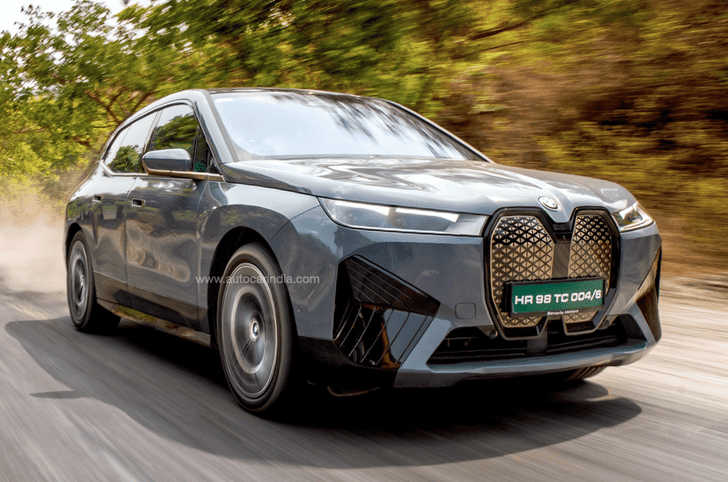Isn’t it ironic? Here I am, sitting behind the wheel of the world’s most radical, forward-thinking, all-electric SUV, and all I can see around me from its bubble-like cockpit are oil refineries and gas storage facilities. On my left, as we drive north along Surat’s ring road, is Hazira, India’s giant gas terminal; mile upon, mile of it. And on the right is an endless row of allied industries.
Different Is The New Normal
My thoughts soon move back to the Model X, an SUV that’s as radically different from any SUV as anything yet. And it isn’t just the looks, the cabin, the propulsion system, the doors, the seats, or a host of other equally silly and fun features. It’s everything.
Let’s start with the design. Unlike most SUVs the Model X has a low nose or bonnet, for low drag. The skinning is nice and clean, and those thick daytime running lamps stand out like white ‘kajal’. Since there’s no need for massive airflow though the cowl, and no big radiator, the front aperture is slim. This helps make X the slipperiest SUV in the world, according to Tesla. The coefficient of drag is just 0.25 Cd. What also contributes is just how tucked in and tight fitting the cabin is. Then there’s the super-slick underfloor and the manner in which the airflow has been controlled around the ‘tight’ fitting wheels. Around the rear, the design of the Tesla X is more BMW X6 like, with a fastback rear. The tail-lights are rather ordinary though and, for all intents and purposes, look like they have been plucked out of someone else’s parts bin.

Truth be told, the X is hardly an off-roader, if you look at its stance. And when the car is at its normal ride height, you have to be careful over speed breakers. Luckily, the air springs can raise the car to 211mm, which is no mean feat as the car weighs a colossal 2.5 tonnes.
A lot of that weight comes from the massive lithium-ion battery pack. Similar to the one in the Model S, it comes in most markets with a choice of 75kWh, 90kWh and 100kWh capacities. The bigger ones weigh close to 600kg, double of what a typical engine and fuel tank weigh.
Having all the weight between the wheels certainly helps weight distribution, and that means the X is less top heavy than most traditional SUVs. In addition, its roof is clearly lower – the car is less than 1.7 metres tall, and since the body is predominantly made from extruded aluminium, reinforced with boron steel, weight has actually been saved.
All Model Xes get electric four-wheel drive, with power supplied by the ‘Tesla’ or three-phase electric motors cradled between each axle. This 100D has a power output of 557hp. You can get a more powerful X now, however, and the new ‘ludicrous mode,’ (now renamed Plaid mode) gives you a simply insane 1,020hp and a superbike-matching 0-100kph time of 2.5sec (with rollout subtracted).
Then there are the fully motorised front doors and the unique double-hinged ‘falcon wing’ rear doors that open with so much drama and pomp, you feel you are exiting the hatch of a spaceship. Brings out the child in you. The falcon doors are practical too. They offer effortless ingress and egress, and the manner in which you can ‘walk’ into the third row without having to crunch down below the roof is just superb.
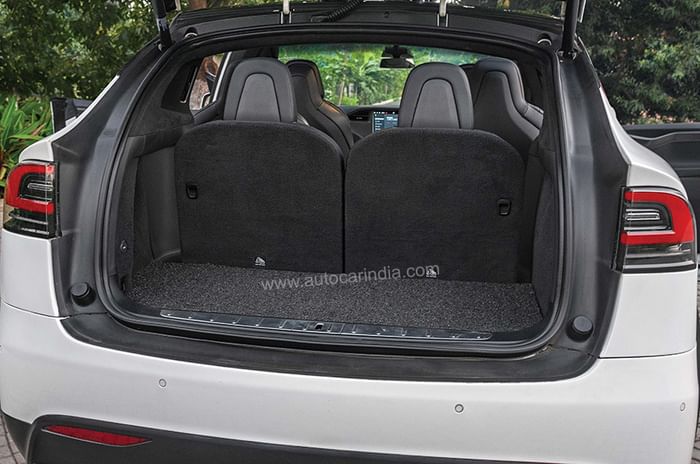
There are a couple of conventional bits on the Model X. For one, it uses the same suspension configuration as the Model S, with double wishbones at the front and multi-links at the rear; it uses off-the-rack air springs and, as on many electric cars, it has twin boots.
Bullet Train
Also unique, and I don’t say this mildly, is the driving experience. To begin with you are sat ‘out there’ in the helicopter-like bubble glass cockpit. The windscreen then curls all the way back and behind your head, and the X even has helicopter-like sun visors . . . that click into place magnetically.
There’s also no starter button. No seriously. The car comes alive as soon as you get in and put your foot on the brake, and if the driver’s door is open, it shuts automatically. All you need to do now is select ‘D’ for drive on the Mercedes-Benz-like gear selector stalk, put your foot on the accelerator (can’t quite call it the gas pedal) and pull away.
As I put my foot down hard, the first hit of acceleration all but knocks me back in my seat. I can’t help but laugh out loud. There’s so much torque from the two motors, and importantly so much traction, the X accelerates like it weighs nothing at all. Shooting off from rest is even more special. There’s no drama and no wheel-spin, it just feels like I’m being shot forward from a bow; a muted whine from the twin Tesla motors audible in the background.
What’s also incredible is just how well the traction control seems to work; it allows power to flow though, but stems any wasteful wheel-spin. Electric traction control systems can be cycled (on and off) much faster.
The performance isn’t just spectacular from rest, put your foot down at almost any speed and it has the ability to just reel in the horizon. This feels surreal, almost like I’m piloting a Bullet train. The illusion for me is further reinforced by the fact that the road ahead is dead straight, we are flanked by Armco on one side, and every time I give it some stick, the median blurs almost instantly. A quick V-box run, with the car in ‘standard’ mode (not the more relaxed ‘Chill’), proves how quick the Tesla is; 0-100kph takes just 4.4sec; and that’s well into performance SUV territory.
The Model X even drives superbly when you are just taking it easy. It’s torquey, smooth, refined (of course), and the power is actually easy to meter compared to other electrics. And, importantly, it doesn’t always feel like it’s ‘chomping-at-the-bit.’
The all-electric advantage isn’t everlasting. By 150kph, some of the Model X’s competition start to haul back the advantage, and then, importantly, the rate of acceleration slopes off marginally. Nevertheless, that sledgehammer-like initial torque in a velvet glove remains Tesla’s calling card. And can you imagine what the 1,020hp Plaid version will be like?
Thoda Sa Adjust Karo
There are many good things about electricity powering a vehicle, but the fact that the battery and motor combination weigh twice as much as a regular engine and gearbox, are not one of them. This makes managing the ride and handling compromise a bit difficult. So, despite having air suspension, the Model X’s ride is firm, and over uneven patches, you get tossed around a bit. Could this have been done better? Sure, you only need to look at Merc’s all-electric EQC that rides, well …. like a Merc.
While the handling is relatively inert, the Model X has body roll well under control and for all its bulk, it feels relatively light on its feet. It helps that the Model X’s weight is located low in the chassis and as a result it rolls less and at a steadier rate than most other SUVs. And that makes a big difference when it needs to change direction. To Tesla’s credit, you don’t quite feel the bulk of the Model X from behind the wheel. Still, this isn’t an SUV that goads you into cornering harder and faster. In fact, up the pace in corners and it sort of starts feeling uncomfortable. Porsche Cayenne Coupe, it certainly isn’t.
Under The Wings
Like almost everything on the Model X, the cabin too is unique. The dash is almost entirely monopolised by the vast portrait infotainment screen. And then because it has that panoramic windscreen, there’s a heightened sense of space up front.
It isn’t just a sense of space. There’s actually loads of shoulder room up front, there’s acres of space in the back with only two seats on the second row, and if you are medium sized, you can even sit comfortably on the third row. Ingress and egress into the rear is also much nicer, with no roof to duck for. The 6-seat configuration we have, however, is a bit odd; individual seats on the second row aren’t spaced evenly. The gap between the left and right seat is huge, and this is because of the large hinges and shroud for the falcon wing doors that sit above your head.
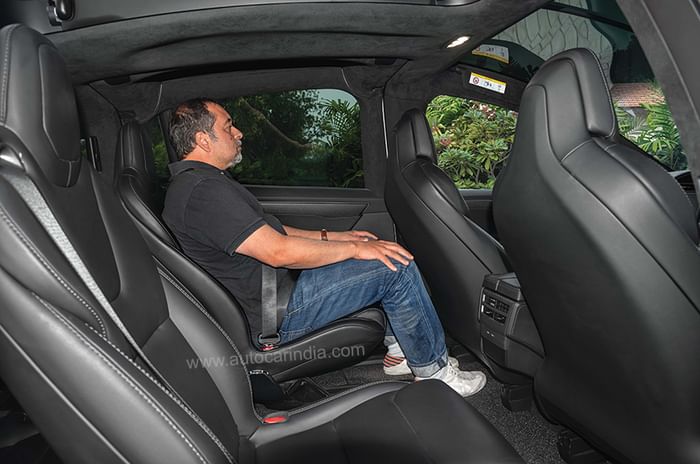
The design of the dash, though sporty and decently put together, doesn’t have the luxurious build quality or material richness of something like a BMW or a Porsche. And nor is the fit and finish in the same league. Luckily, it’s the giant 17-inch screen that takes up all your attention. The touchscreen function is iPad good, satellite maps at full brightness put out lush details and high contrast, and pinch and expand as fast as you want, and the screen is quick and always with you; no lag discernible.
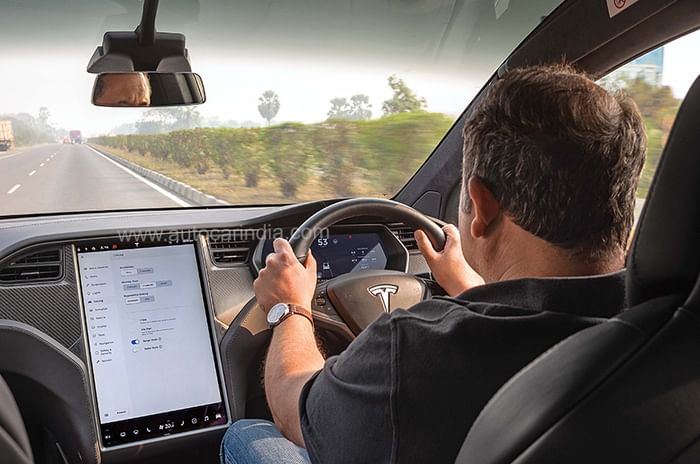
While the fan and temperature controls are digital, it helps that they sit on a permanent bar that is always at the bottom. And I particularly like the fact that you have a web browser at hand. Other cool features on the screen include a real-time pictogram of the car while the doors close, you can see the seats move in real time as you adjust them from the screen, there’s a sketch pad app for your kids and then, since this is a family car, there are loads of things with which to keep the kids entertained. Stuff like a screen that allows you to show that your car is on Mars. The car on the screen can be turned into a submersible Lotus Esprit from a James Bond movie, and it can even display a jump to light speed effect from Star Wars.
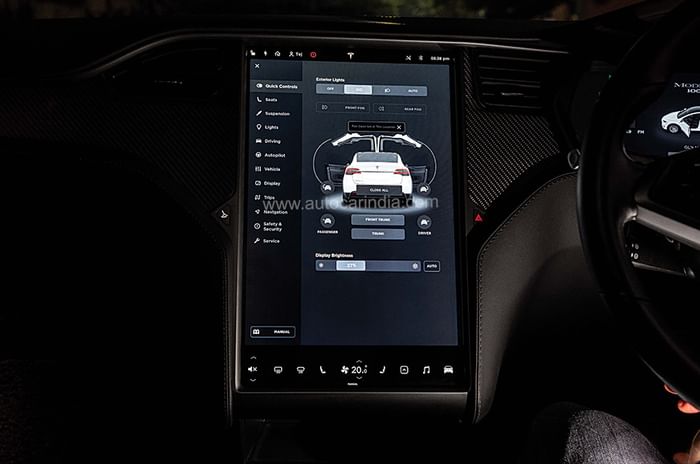
Electric Dreams
Tesla’s Model X is like no other luxury SUV. Smooth, easy to drive and in possession of plenty of all-electric grunt, it is also quick, entertaining and loads of fun to drive in a straight line. With its low-slung battery, good four-wheel-drive traction and stiff air springs, it is pretty agile and enjoyable to drive in corners too. It isn’t an SUV that enjoys being driven hard, as you would a Merc AMG or an M car from BMW, the ride is a bit stiff, the cabin isn’t up to quality standards seen on German luxury cars and with no chargers on our highways yet, it’s unlikely to be the car you can travel long distances in.
What makes the Model X unique and genuinely refreshing is that it is so different. The falcon wing doors play a big role, the unique seating position is clever, and then that big touchscreen has so much tech packed in it, it makes for a great user experience.
There’s no clear indication of when the Model X will go on sale in India, or what it will be priced at (we expect a price of around Rs 1.5 crore), but if you are looking for something genuinely different, have the ability to install a charger at home, and don’t mind dealing with some of its quirks, Tesla’s take on an SUV is a refreshing breath of air. A luxury SUV that, without a doubt, makes every other conventional one seem ancient.
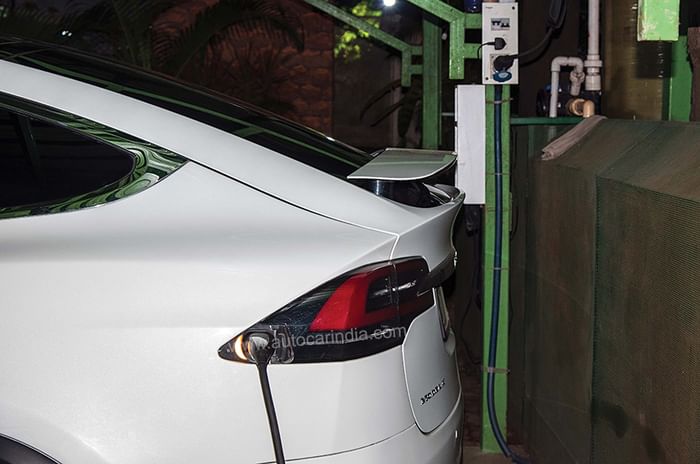
Motor And Batteries
Tesla’s now famous Induction motor and Inverter combination give it a unique set of qualities. Invented more than a century ago by the American-Serbian scientist Nikola Tesla, the Induction motor uses a three-phase alternating current in the coil to produce a rotating magnetic field. This rotating magnetic field or RMF induces a current on the rotor that helps make it spin. In an induction motor, the speeds depend on the frequency of the alternating current supplied. So, up the frequency, and the speed at which the motor turns can be increased, and that makes controlling the drive speed easy. The induction motor, importantly, has no permanent magnet.
Power for the electric motor comes from a battery pack. Tesla uses cylindrical type cells, similar in basic construction to pencil cells, where positive and negative electrode are placed in layers, and then rolled together. Separators and casings keeping the various layers apart.
DC power from the battery pack then flows to the inverter, which converts it to AC for use by the induction motor. The inverter also controls the motor speed. Increase the amplitude of the current and the induction motor can even be made to produce more power; giving it a unique advantage.
Tesla In India
It’s official; Tesla is finally headed to India. Confirmation of the same was put out by rocket-man and CEO, Elon Musk, via Twitter. The Indian company is in the process of being incorporated in Bengaluru, and is looking at various locations to set up its manufacturing plant. Gujarat is one such location being considered, and there are a bunch of others too.
The move to setup the company’s India operations have been a long time coming. Prime Minister Narendra Modi visited the Tesla plant in 2015, and Musk started his dalliance with India in 2017, when Tesla accepted booking amounts for the Model 3 from Indian customers.
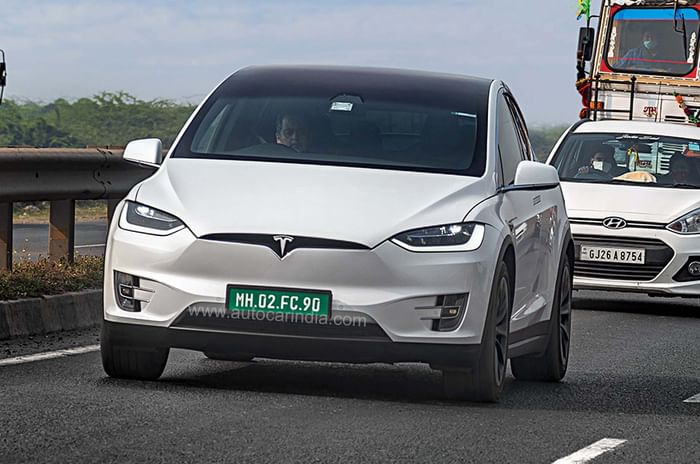
The need for India to move to a more electric car dependent transport structure is an obvious one. As long as the move is natural, not forced and non-disruptive, the benefits are likely to be huge. And with sales of luxury cars increasing steadily, Tesla could be moving in at just the right time. But where exactly will Tesla setup its plant and when will India’s assembled cars begin rolling off the production line? We’ll have the answers soon.











